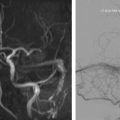Pulsatile tinnitus from intracranial venous abnormalities is an uncommon cause of pulse synchronous tinnitus. Endovascular therapies may have applications in many of these disease conditions. They have the advantage of being minimally invasive and may selectively eliminate the site of turbulence. Venous stenting has been used successfully to treat venous stenoses with low complication rates and high success rates in patients with idiopathic intracranial hypertension though randomized controlled data are lacking. Careful exclusion of other causes of tinnitus should be performed before consideration for surgical or endovascular treatment of presumed causative lesions of venous tinnitus.
Venous abnormalities such as venous diverticulae or fenestrations may rarely cause venous tinnitus, and in select cases, may be successfully treated with venous embolization or stenting.
Venous abnormalities such as venous diverticulae or fenestrations may rarely cause venous tinnitus, and in select cases, may be successfully treated with venous embolization or stenting.
Endovascular Treatment Considerations
Endovascular treatment of congenital venous abnormalities has not been well described and no significant data exist. Although the aim of treatment may be to disconnect aberrant veins with occlusive agents, eliminating conducted pulsatile vibrations to the inner ear, the resulting alterations in normal venous drainage could result in venous thrombosis and venous hypertension complications such as ischemia, hemorrhage, and intracranial hypertension. Embolic agents should be sized to the vessel of interest and detachable coils are primarily chosen to eliminate abnormal emissary veins. Detachable coils are preferred to liquid embolic agents due to their controllable detachment to prevent venous migration. Experience with fenestrations and webs is limited and stent reconstruction may be considered, with the cautionary note that inadvertent reduction of venous outflow may result in venous hypertension. Analogous to venous diverticula or dehiscence lesions, preoperative testing across these venous variants should be performed before intervention with balloon occlusion or venous pressure measurements to ascertain a functional or hemodynamic impairment related to the venous anomaly.
References
- 1. Chandler J.R.: Diagnosis and cure of venous hum tinnitus. Laryngoscope 1983; 93: pp. 892-895
- 2. Hoare D.J., Kowalkowski V.L., Kang S., et al: Systematic review and meta-analyses of randomized controlled trials examining tinnitus management. Laryngoscope 2011; 121: pp. 1555-1564
- 3. Dobie R.A.: A review of randomized clinical trials in tinnitus. Laryngoscope 1999; 109: pp. 1202-1211
- 4. Shah S.B., Lalwani A.K., and Dowd C.F.: Transverse/sigmoid sinus dural arteriovenous fistulas presenting as pulsatile tinnitus. Laryngoscope 1999; 109: pp. 54-58
- 5. Sismanis A.: Pulsatile tinnitus. A 15-year experience. Am J Otol 1998; 19: pp. 472-477
- 6. Johnston I.H., and Rowan J.O.: Raised intracranial pressure and cerebral blood flow 3. Venous outflow tract pressures and vascular resistances in experimental intracranial hypertension. J Neurol Neurosurg Psychiatry 1974; 37: pp. 392-402
- 7. Karahalios D.G., Rekate H.L., Khayata M.H., et al: Elevated intracranial venous pressure as a universal mechanism in pseudotumor cerebri of varying etiologies. Neurology 1996; 46: pp. 198-202
- 8. Sugerman H.J., DeMaria E.J., Felton W., et al: Increased intra-abdominal pressure and cardiac filling pressures in obesity-associated pseudotumor cerebri. Neurology 1997; 49: pp. 507-511
- 9. Johnston I., Kollar C., Dunkley S., et al: Cranial venous outflow obstruction in the pseudotumour syndrome: incidence, nature and relevance. J Clin Neurosci 2002; 9: pp. 273-278
- 10. Farb R.I., Vanek I., Scott J.N., et al: Idiopathic intracranial hypertension the prevalence and morphology of sinovenous stenosis. Neurology 2003; 60: pp. 1418-1424
- 11. Rohr A., Dörner L., Stingele R., et al: Reversibility of venous sinus obstruction in idiopathic intracranial hypertension. AJNR Am J Neuroradiol 2007; 28: pp. 656-659
- 12. Biousse V., Ameri A., and Bousser M.G.: Isolated intracranial hypertension as the only sign of cerebral venous thrombosis. Neurology 1999; 53: pp. 1537-1542
- 13. Cognard C., Casasco A., Toevi M., et al: Dural arteriovenous fistulas as a cause of intracranial hypertension due to impairment of cranial venous outflow. J Neurol Neurosurg Psychiatry 1998; 65: pp. 308-316
- 14. Sinclair A.J., Burdon M.A., Nightingale P.G., et al: Low energy diet and intracranial pressure in women with idiopathic intracranial hypertension: prospective cohort study. BMJ 2010; 341: pp. c270
- 15. Sugerman H.J., Felton W.L., Sismanis A., et al: Gastric surgery for pseudotumor cerebri associated with severe obesity. Ann Surg 1999; 229: pp. 634
- 16. Johnson L.N., Krohel G.B., Madsen R.W., et al: The role of weight loss and acetazolamide in the treatment of idiopathic intracranial hypertension (pseudotumor cerebri). Ophthalmology 1998; 105: pp. 2313-2317
- 17. Alore P.L., Jay W.M., and Macken M.P.: Topiramate, pseudotumor cerebri, weight-loss and glaucoma: an ophthalmologic perspective. In (eds): . United Kingdom: Informa UK Ltd, 2006. pp. 15-17
- 18. Rosenberg M.L., Corbett J.J., Smith C., et al: Cerebrospinal fluid diversion procedures in pseudotumor cerebri. Neurology 1993; 43: pp. 1071-1072
- 19. Thambisetty M., Lavin P.J., Newman N.J., et al: Fulminant idiopathic intracranial hypertension. Neurology 2007; 68: pp. 229-232
- 20. Agarwal M.R., and Yoo J.H.: Optic nerve sheath fenestration for vision preservation in idiopathic intracranial hypertension. Neurosurg Focus 2007; 23: pp. E7
- 21. Owler B.K., Parker G., Halmagyi G.M., et al: Pseudotumor cerebri syndrome: venous sinus obstruction and its treatment with stent placement. J Neurosurg 2003; 98: pp. 1045-1055
- 22. Radvany M.G., Solomon D., Nijjar S., et al: Visual and neurological outcomes following endovascular stenting for pseudotumor cerebri associated with transverse sinus stenosis. J Neuroophthalmol 2013; 33: pp. 117-122
- 23. Arac A., Lee M., Steinberg G.K., et al: Efficacy of endovascular stenting in dural venous sinus stenosis for the treatment of idiopathic intracranial hypertension. Neurosurg Focus 2009; 27: pp. E14
- 24. Owler B.K., Parker G., Halmagyi G.M., et al: Cranial venous outflow obstruction and pseudotumor cerebri syndrome. In Pickard J.D., (eds): Advances and technical standards in neurosurgery. Vienna (Austria): Springer, 2005. pp. 107-174
- 25. Ahmed R.M., Wilkinson M., Parker G.D., et al: Transverse sinus stenting for idiopathic intracranial hypertension: a review of 52 patients and of model predictions. AJNR Am J Neuroradiol 2011; 32: pp. 1408-1414
- 26. Puffer R.C., Mustafa W., and Lanzino G.: Venous sinus stenting for idiopathic intracranial hypertension: a review of the literature. J Neurointerv Surg 2013; 5: pp. 483-486
- 27. Waldvogel D., Mattle H.P., Sturzenegger M., et al: Pulsatile tinnitus—a review of 84 patients. J Neurol 1998; 245: pp. 137-142
- 28. Sonmez G., Basekim C.C., Ozturk E., et al: Imaging of pulsatile tinnitus: a review of 74 patients. Clin Imaging 2007; 31: pp. 102-108
- 29. Ward P.H., Babin R., Calcaterra T.C., et al: Operative treatment of surgical lesions with objective tinnitus. Ann Otol Rhinol Laryngol 1975; 84: pp. 473-482
- 30. Golueke P.J., Panetta T., Sclafani S., et al: Tinnitus originating from an abnormal jugular bulb: treatment by jugular vein ligation. J Vasc Surg 1987; 6: pp. 248-251
- 31. Mehanna R., Shaltoni H., Morsi H., et al: Endovascular treatment of sigmoid sinus aneurysm presenting as devastating pulsatile tinnitus a case report and review of literature. Interv Neuroradiol 2010; 16: pp. 451-454
- 32. Signorelli F., Mahla K., and Turjman F.: Endovascular treatment of two concomitant causes of pulsatile tinnitus: sigmoid sinus stenosis and ipsilateral jugular bulb diverticulum. Case report and literature review. Acta Neurochir (Wien) 2012; 154: pp. 89-92
- 33. Weekamp H.H., Huygen P.L., Merx J.L., et al: Longitudinal analysis of hearing loss in a case of hemosiderosis of the central nervous system. Otol Neurotol 2003; 24: pp. 738-742
- 34. Weissman J.L., and Hirsch B.E.: Imaging of tinnitus: a review. Radiology 2000; 216: pp. 342-349
- 35. Narvid J., Do H.M., Blevins N.H., et al: CT angiography as a screening tool for dural arteriovenous fistula in patients with pulsatile tinnitus: feasibility and test characteristics. AJNR Am J Neuroradiol 2011; 32: pp. 446-453
- 36. Meckel S., Maier M., Ruiz D.S., et al: MR angiography of dural arteriovenous fistulas: diagnosis and follow-up after treatment using a time-resolved 3D contrast-enhanced technique. AJNR Am J Neuroradiol 2007; 28: pp. 877-884
- 37. Lambert P.R., and Cantrell R.W.: Objective tinnitus in association with an abnormal posterior condylar emissary vein. Am J Otol 1986; 7: pp. 204-207
- 38. Wadin K., Thomander L., and Wilbrand H.: Effects of a high jugular fossa and jugular bulb diverticulum on the inner ear a clinical and radiologic investigation. Acta Radiol Diagn (Stockh) 1986; 27: pp. 629-636
- 39. Couloigner V., Grayeli A.B., Bouccara D., et al: Surgical treatment of the high jugular bulb in patients with Meniere’s disease and pulsatile tinnitus. Eur Arch Otorhinolaryngol 1999; 256: pp. 224-229
- 40. Jackler R.K., Brackmann D.E., and Sismanis A.: A warning on venous ligation for pulsatile tinnitus. Otol Neurotol 2001; 22: pp. 427-428
- 41. Grewal A.K., Kim H.Y., Comstock R.H., et al: Clinical presentation and imaging findings in patients with pulsatile tinnitus and sigmoid sinus diverticulum/dehiscence. Otol Neurotol 2014; 35: pp. 16-21
- 42. Otto K.J., Hudgins P.A., Abdelkafy W., et al: Sigmoid sinus diverticulum: a new surgical approach to the correction of pulsatile tinnitus. Otol Neurotol 2007; 28: pp. 48-53
- 43. Eisenman D.J.: Sinus wall reconstruction for sigmoid sinus diverticulum and dehiscence: a standardized surgical procedure for a range of radiographic findings. Otol Neurotol 2011; 32: pp. 1116-1119
- 44. Gologorsky Y., Meyer S.A., Post A.F., et al: Novel surgical treatment of a transverse-sigmoid sinus aneurysm presenting as pulsatile tinnitus: technical case report. Neurosurgery 2009; 64: pp. E393-E394
- 45. Shihada R., Maimon S., Braun J., et al: Endovascular embolization of a hemorrhagic jugular bulb diverticulum. Int J Pediatr Otorhinolaryngol 2008; 72: pp. 1445-1448
- 46. Houdart E., Chapot R., and Merland J.J.: Aneurysm of a dural sigmoid sinus: a novel vascular cause of pulsatile tinnitus. Ann Neurol 2000; 48: pp. 669-671
- 47. Gard A.P., Klopper H.B., and Thorell W.E.: Successful endovascular treatment of pulsatile tinnitus caused by a sigmoid sinus aneurysm a case report and review of the literature. Interv Neuroradiol 2009; 15: pp. 425-428
- 48. Park Y.H., and Kwon H.J.: Awake embolization of sigmoid sinus diverticulum causing pulsatile tinnitus: simultaneous confirmative diagnosis and treatment. Interv Neuroradiol 2011; 17: pp. 376-379
- 49. Zenteno M., Murillo-Bonilla L., Martínez S., et al: Endovascular treatment of a transverse-sigmoid sinus aneurysm presenting as pulsatile tinnitus: case report. J Neurosurg 2004; 100: pp. 120-122
- 50. Amans M.R., Stout C., Dowd C.F., et al: Resolution of pulsatile tinnitus after coil embolization of sigmoid sinus diverticulum. Austin J Cerebrovasc Dis Stroke 2014; 1: pp. 1-3
- 51. Sanchez T.G., Murao M., de Medeiros I.R., et al: A new therapeutic procedure for treatment of objective venous pulsatile tinnitus. Int Tinnitus J 2002; 8: pp. 54-57
Stay updated, free articles. Join our Telegram channel

Full access? Get Clinical Tree





